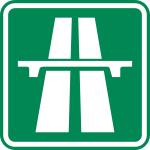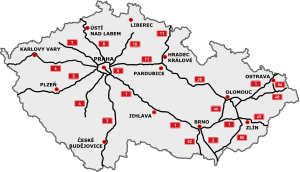Highways in the Czech Republic


Highways in the Czech Republic are no longer divided into motorways and expressways as the category of expressways (rychlostní silnice) has been abolished by 31 December 2015. Most of expressways were classified as fully fledged motorways, while some sections of the former expressways were suspended to common dual carriageway roads with a traffic sign of a road for motorcars (silnice pro motorová vozidla) whose speed limit is of up to 110 km/h, as they do not comply with the standards of motorway. This concerned especially the expressway R35 between Liberec and Turnov which has been classified as of 1 January 2016 as a road for motorcars (with a speed limit of up to 130 km/h).
The motorways are managed by the state-owned Road and Motorway Directorate of the Czech Republic – ŘSD ČR, established in 1997. The ŘSD currently manages and maintains 1,213 km of motorways (dálnice), whose speed limit is of 130 km/h or 80 mph (or 80 km/h or 50 mph within a town). The present-day national motorway network is due to be of about 2,000 km before 2030.[1]
Toll requirements


For motorcars with a maximum authorized mass of up to 3.5 tonnes, motorways in the Czech Republic (with some exceptions) are subject to a time-based fee (časový poplatek) paid with the purchase of a windscreen toll vignette (dálniční známka or dálniční kupón) with a validity of either 10 days (310 CZK), 1 month (440 CZK) or 1 year (1500 CZK). The following motorway sections are toll-free for cars up to 3.5 t:[2]
- motorway D1 between Kývalka (exit 182) and Holubice (exit 210; 28 km)
- motorway D3 between Čekanice (exit 76) and Měšice (exit 79; 3 km)
- motorway D6 between Jesenice (exit 162) and Cheb–západ (exit 169; 7 km)
- motorway D10 between Bezděčín (exit 39) and Kosmonosy (exit 46; 7 km)
As of 1 January 2007 a new system of electronic toll aka a distance toll for vehicles with a weight exceeding 12 tons has been introduced for motorways and some roads of the first class (silnice první třídy), totally cca 200 km.[3] As of 1 January 2010, this applies also to vehicles over 3.5 tons. There is an ongoing public discussion on imposition of electronic toll for all cars and vehicles.
.jpg) A road sign informing of the beginning of the motorway vignette (toll label) duty for cars ≤ 3.5t
A road sign informing of the beginning of the motorway vignette (toll label) duty for cars ≤ 3.5t A road sign informing of the beginning of the electronic toll duty for vehicles > 3.5t
A road sign informing of the beginning of the electronic toll duty for vehicles > 3.5t.jpg) A road sign informing of the beginning of both motorway vignette (toll label) and electronic toll duty
A road sign informing of the beginning of both motorway vignette (toll label) and electronic toll duty A road sign informing of the end of both motorway vignette (toll label) and electronic toll duty
A road sign informing of the end of both motorway vignette (toll label) and electronic toll duty
History of Czech motorways
Before the Second World War



First informal plans of a motorway (called firstly in Czech autostráda or dálková silnice) in Czechoslovakia date back to 1935 and was to link Prague through Slovakia with Czechoslovak easternmost territory of Carpathian Ruthenia (nowadays Zakarpattia Oblast in Ukraine) being Velykyy Bychkiv (Velký Bočkov in Czech) its end on the Czechoslovak - Romanian border. The definitive route, including a Prague ring motorway, was approved shortly after the Munich Agreement on 4 November 1938 for a planned speed limit of 120 km/h.
Nazi authorities also made the second Czecho-Slovak Republic, already a German satellite state, build up a part of the Reichsautobahn Breslau - Vienna as an extraterritorial German motorway with border checkpoints at each motorway exit. However, only a construction of the route within Bohemia and Moravia was initiated, but never finished. It still sporadically appears in some current Czech motorway plans.
On 1 December 1938 the Nazi Germany had already initiated a construction of so-called Sudetenautobahn (in Sudetenland, before the Munich agreement a part of Czechoslovakia, then of Germany) in the route Streitau (Bavaria) – Eger – Carlsbad – Lobositz – Leipa a. d. Polzen – Reichenberg (capital of Sudetenland) – Görlitz (in Prussia, now in Saxony). The autobahn has never been finished, but some remnants in the landscape close to Pomezí nad Ohří, Cheb/Eger and Liberec/Reichenberg are still prominent and a not finished part from Svárov via Machnín to Chrastava was used in the construction of the road for motorcars I/35.
The Time of the Nazi Occupation
After the breakdown of Czechoslovakia following a declaration of independence of the Slovak Republic and of the short-lived Carpatho-Ukraine which was a prelude to the German occupation of Bohemia and Moravia on 15 March 1939, a decision to build the motorway only to the Slovak border was adopted. The technical parameters of motorways (speed limit of 140 – 160 km/h) were adjusted to those of German Reichsautobahn as Czech (Bohemian-Moravian) motorways should be integrated within the German Reichsautobahn network.
The project for the first segment Prague - Lužná was ready in January 1939, and the construction in Moravia began on 24 January in Chřiby on the Zástřizly - Lužná segment. The construction in Bohemia from Prague on began on 2 May 1939, with switch to right-hand traffic in Bohemia and Moravia already gone without a hitch. The motorway should have reached Brno in 1940, but building materials and labour shortage due to an absolute priority of the nazi armament industry delayed considerably the work. The construction in the route of approx. 77 km from Prague towards Brno advanced notably when a prohibition of all civil constructions by German authorities came into force in 1942.
After the Second World War
After the Second World War, the completion only of the first and unfinished 77 km of the motorway Prague - Brno up to Humpolec was approved by the Government in November 1945 and was reinaugurated in 1946. The construction sites of the partly inaugurated construction of the Sudetenautobahn (28 km) were completely abandoned, as well as that of the Breslau - Vienna motorway (84 km). The latter was, however, incorporated in some plans as a future connection motorway between Brno and the D35 motorway. Just finishing of some large bridges and a concrete surface on the 77 km of the Prague - Humpolec motorway lacked when the new communist government decided to discontinue completely the work in early 1950.
Only on 8 August 1967 the Government of the Socialist Republic of Czechoslovakia resolved to continue the construction of motorways by adopting a new motorway plan for the whole country and passed a resolution of continuation of the already twice interrupted construction of the motorway Prague - Brno (number D1) and further Brno - Bratislava (D2). The construction was solemnly inaugurated on 8 September 1967. Due to a change of technical parameters, some bridges finished before 1950 were replaced. The Prague - Brno motorway (D1), initiated on 2 May 1939, reached Brno in 1980, full 40 years after in the beginning scheduled opening.
The pace of construction of highways has always been rather slow up to the present days. The first 100 km of highways on the territory of today's Czech Republic were completed in 1975, 500 km in 1985 and 1,000 in 2007. Funding for the construction of highways was radically reduced after the crisis in 2008 due to draconian budget cuts and is currently gaining momentum rather slowly for various reasons.
Motorways
.jpg)
The motorways in the Czech Republic, Czech: dálnice (abbr. D), are defined as two-lane motorways in each direction, with an emergency lane. The speed limit is 130 km/h or 80 mph. Their highway shields are white on red and road signs are white on green. As of 1 January 2016, the Czech motorway network comprises 18 motorways. Nowadays, 17 of them are at least partially operational, but only 4 (D2, D5, D10 and D46) have been completed, another one (D8) is near completion by the end of 2016.
The number of a motorway reflects a number of the previous national road alongside which it was built up or which it shall replace. After the construction of the motorway, the affected national road is degraded to a regional road with a number beginning on 5 or 6 and having 3 digits. For instance, after the completion of the D8 motorway (Prague - Lovosice), the previous national road no. I/8 between Prague and Lovosice became a regional road no. 608. Regional roads are maintained by the self-governing regions (kraj) and not by the state directly.
Originally, a motorway D47 was planned from Brno to Ostrava and construction in the section Lipník nad Bečvou - Ostrava under this number even started, but in the end the ŘSD in 2006 decided that the D47 should be classified as an extension of the D1 motorway.
Roads for motorcars

As of 2016, the former expressways that don't meet motorway standards, have been classified as roads for motorcars (silnice pro motorová vozidla). Those common roads are not subject to a fee (in form of a vignette) for vehicles with total weight up to 3.5 t and their high speed limit is of 110 km/h, partially up to 130 km/h. The signs on roads for motorcars have, like on other common roads, a white text on a blue background (unlike on motorways, where the background is green).
It is in the jurisdiction of the region (kraj) to decide whether it will be permitted to raise the speed-limit on the road for motorcars up to 110 km/h or even to 130 km/h.
Opening of new motorways
Construction of new motorways in recent years has been hampered due to corruption scandals and austerity measures as well as owing to new European rules under which old EIA assessments lapsed. See the table bellow.[5] However, this should improve slightly in next years. As of 2016, there are 68.2 km of new motorways under construction, in 2017 a construction of further 110.3 km should be initiated (apart from the ongoing reconstruction of the motorway D1).[6] Currently, only 12.5 km of new motorways may open to public in 2016, 17.5 km in 2017, 18.1 km in 2018 and 28 km in 2019.
Between the years 1971 - 2014 the average year pace of completion of new highways was 28.2 km a year. [7]
| |
From | To | Length | Construction started | Due to open | Remarks |
|---|---|---|---|---|---|---|
| Bílinka | Řehlovice | 12.5 km | 11/2007 | 12/2016 | D8 will be 100% completed, currently problems with a moving slope | |
| Praskačka | Hradec Králové | 4.4 km | 07/2014 | 05/2017 | to be continued to Jaroměř | |
| Skalka | junction with road no. II/118 | 4.8 km | 04/2015 | 08/2017 | ||
| Veselí nad Lužnicí | Bošilec | 5.1 km | 04/2015 | 09/2017 | ||
| Borek | Úsilné | 3.2 km | 04/2015 | 10/2017 | ||
| Postoloprty | Bitozeves | 3.8 km | 09/2016 | 04/2018 | ||
| Přerov | Lipník nad Bečvou | 14.3 km | 07/2015 | 08/2018 | penultimate section of D1 |
See also
References
- ↑ http://www.ceskedalnice.cz/
- ↑ http://www.sfdi.cz/en/highway-toll-and-vignettes/2016-highway-vignettes/toll-sections/
- ↑ http://www.mytocz.eu/files/images/maps/MYTOCZ_381_toll_map.gif
- ↑ https://www.rsd.cz/wps/portal/web/Silnice-a-dalnice/delky-a-dalsi-data-komunikaci Ředitelství silnic a dálnic ČR: Délky a další data komunikací
- ↑ http://www.ceskedalnice.cz/dalnicni-sit/ve-stavbe/
- ↑ http://www.mdcr.cz/NR/rdonlyres/EC2805A9-3817-423C-A458-12420C2727FB/0/MD_tabulkaseznamstaveb.xls
- ↑ http://www.ceskedalnice.cz/prilohy/data.pdf
External links
| Wikimedia Commons has media related to Highways in the Czech Republic. |